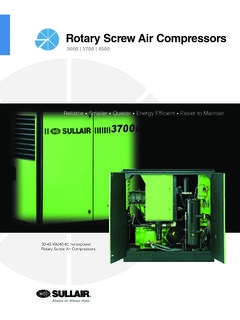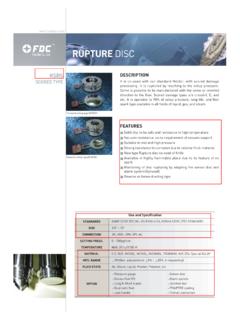Transcription of Hydraulic Conveying of Plastic Pellets - burchamintl.com
1 Hydraulic Conveying OF Plastic Pellets Hans J. Schmidt, Coperion Corp., Ramsey, NJ Abstract Today s Plastic production plants can have a yearly capacity of more than 400,000 t. New catalysts enable them to produce a great variety of increasingly softer product grades in the same reactor. Together with logistic concepts that increase Conveying distances, the polymer industry has reached the limits of traditional dilute and dense phase pneumatic Conveying systems. This paper presents a new concept to convey Plastic Pellets as water slurry to overcome the limitations of pneumatic Conveying . A further benefit of this technology is the gentle handling of attrition sensitive plastics like Polycarbonate and Polyester. Background In general dilute phase Conveying with high capacity over long distance is technically possible.
2 Due to the resulting large pipe diameter and therefore high Conveying velocity there will be substantial attrition of polymer dust (1). This dust reduces the final product quality, has to be removed and will be lost production. With softer polymers there will be the formation of streamers that can cause production and of course quality problems as they are difficult to separate. Single line dense phase low velocity Conveying systems have definite limitations in distance as well. Pipe diameters have to stay below 300 mm in order to keep the pipe shock forces, resulting from the moving product slugs, within a manageable range. Figure 1 shows the limits for product mass flow versus Conveying distance for today s bandwidth of Polyethylene Pellets .
3 Basis for this graph is a 315 mm pipe and a Conveying pressure of 6 bar which is the practical limit of available rotary feeders. This graph shows that the Conveying capacity for softer LLDPE grades and a typical Conveying distance of 200 m is limited to 50 t/h. With extruder capacities of 70 t/h and still increasing demand this will be the ideal application for Hydraulic Conveying . The benefit of using water instead of air as the transport medium is that the specific density of the polymer is relatively close to the specific density of water. The pressure loss is calculated as pressure loss of the Conveying medium without product plus the additional pressure loss due to the product.
4 In both, pneumatic and Hydraulic Conveying , the pressure loss due to the Conveying medium is a smooth function of the Conveying velocity (Figure 2). The additional pressure loss due to the product in a horizontal pipe is caused by friction or better called slip , which is defined as the difference between the medium and the pellet velocity. The slip in water slurry and therefore the additional pressure loss due to the product is a much smaller portion of the total pressure loss compared to pneumatic Conveying . Figure 2 shows this relationship from test data taken in a 65 mm pipe. This physical effect also helps to make Hydraulic Conveying more tolerant for product grade changes than pneumatic transport, which normally is a serious influencing factor on pressure loss and therefore system performance especially with softer grades.
5 Air as the Conveying medium in pneumatic Conveying systems is a compressible gas. As the Conveying pressure decreases from the pickup point towards the terminal point, the gas velocity increases. In a Hydraulic Conveying system the medium water is not compressible. The water velocity will therefore be constant throughout the entire length of the Conveying pipe. This constant low velocity and the small slip are the reason for an up to 65% lower energy consumption of the Hydraulic Conveying . Typical slurry velocities in Hydraulic Conveying systems are in the range of m/s. They are related to factors like minimum required Conveying velocity and residence time of the product in water. The minimum velocity depends on the polymer density similar to pneumatic Conveying (1) and is increasing with increasing density.
6 Table 1 shows feasible capacities in various pipe sizes for LLDPE and a volumetric concentration of Pellets in the slurry of 25%. Figure 3 shows the relationship of pellet mass flow versus Conveying pipe diameter for Hydraulic , dilute and dense phase Conveying . Even when reaching the technical limits with the pneumatic Conveying , the Hydraulic Conveying needs just 50% of the pipe diameter. Hydraulic Conveying Concept Figure 4 shows a typical Hydraulic Conveying concept. The Pellets are removed from the pelletizing water loop either by a dryer or a dewatering device. The Pellets then enter the agitator bin, where a rotating paddle creates a controlled, homogeneous mixture of Pellets and water. The slurry passes through the Conveying pump to the concentrator.
7 Here a controlled volume flow of water is drained from the slurry, to create the desired volumetric pellet concentration for the Conveying . It is important to note that the concentrator is controlling the velocity and the concentration in the Conveying line independent of the conditions at the slurry pump. The resulting slurry is 424 / ANTEC 2004conveyed to the dryer inlet at the terminal point. Pellets are separated from the slurry and dried. The water passes through a filtration device into a storage tank, and is then pumped back to the storage tank in the pelletizing area. From the storage tank water is fed by gravity to the agitator bin. The water temperature in the return line is controlled. This is necessary since typically a temperature of 50 - 60 C must be maintained at the dryer inlet in order to ensure drying results (2).
8 A further concept is to combine the water return loops of the pelletizer and the Hydraulic Conveying system, thus sharing the water filtration and water storage tank. The obvious benefit is to eliminate one filtration system and one storage tank to reduce capital investment and maintenance cost. A second benefit is the saving of energy. The pelletizing loop is continually cooled to remove the heat introduced by the polymer melt. The Conveying loop on the other hand is continually heated to satisfy the dryer inlet conditions. By combining both water streams the Conveying system can assist in cooling the pelletizing loop and therefore conserve energy. Temperature and Conveying pressure are influencing the pelletizer performance and have to be considered in this concept.
9 To gain the most benefit from the Hydraulic Conveying system it is important to look into the overall plant layout concept. A typical finishing area can be divided into extrusion and logistics area. Figure 5 shows a concept, where the Hydraulic Conveying system is directly following the pelletizing loop. The blending silos are located in the logistics area next to the storage silos. The advantage of this arrangement is, that only one pellet dryer is required. On the other hand, it is a disadvantage that the overall pneumatic Conveying distance, which includes the recirculation around the blenders, can be quite long. There might still be the need for pellet cleaning equipment or the final product quality will be reduced.
10 Figure 6 shows a second possible plant concept. In this concept, the Hydraulic Conveying system is located downstream of the blenders, which offers several advantages: The dust that is created during pneumatic Conveying to and recirculation around the blenders will be removed by the Hydraulic Conveying system. It washes the Pellets clean. The required Conveying rate downstream of the blenders is typically higher than directly downstream the pelletizer. In using Hydraulic Conveying at this point we take advantage of its strength to be more efficient with high capacities over long distances. The overall pneumatic Conveying distance after the blender and the Hydraulic Conveying system dryer is minimized, which improves final product quality.




